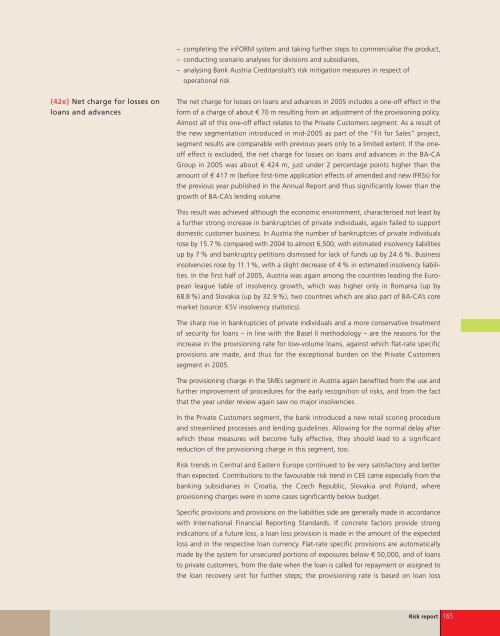team spirit - Bankier.pl
team spirit - Bankier.pl
team spirit - Bankier.pl
You also want an ePaper? Increase the reach of your titles
YUMPU automatically turns print PDFs into web optimized ePapers that Google loves.
(42e) Net charge for losses on<br />
loans and advances<br />
– com<strong>pl</strong>eting the inFORM system and taking further steps to commercialise the product,<br />
– conducting scenario analyses for divisions and subsidiaries,<br />
– analysing Bank Austria Creditanstalt’s risk mitigation measures in respect of<br />
operational risk<br />
The net charge for losses on loans and advances in 2005 includes a one-off effect in the<br />
form of a charge of about € 70 m resulting from an adjustment of the provisioning policy.<br />
Almost all of this one-off effect relates to the Private Customers segment. As a result of<br />
the new segmentation introduced in mid-2005 as part of the “Fit for Sales” project,<br />
segment results are comparable with previous years only to a limited extent. If the oneoff<br />
effect is excluded, the net charge for losses on loans and advances in the BA-CA<br />
Group in 2005 was about € 424 m, just under 2 percentage points higher than the<br />
amount of € 417 m (before first-time ap<strong>pl</strong>ication effects of amended and new IFRSs) for<br />
the previous year published in the Annual Report and thus significantly lower than the<br />
growth of BA-CA’s lending volume.<br />
This result was achieved although the economic environment, characterised not least by<br />
a further strong increase in bankruptcies of private individuals, again failed to support<br />
domestic customer business. In Austria the number of bankruptcies of private individuals<br />
rose by 15.7 % compared with 2004 to almost 6,500, with estimated insolvency liabilities<br />
up by 7 % and bankruptcy petitions dismissed for lack of funds up by 24.6 %. Business<br />
insolvencies rose by 11.1%, with a slight decrease of 4 % in estimated insolvency liabilities.<br />
In the first half of 2005, Austria was again among the countries leading the European<br />
league table of insolvency growth, which was higher only in Romania (up by<br />
68.8 %) and Slovakia (up by 32.9 %), two countries which are also part of BA-CA’s core<br />
market (source: KSV insolvency statistics).<br />
The sharp rise in bankruptcies of private individuals and a more conservative treatment<br />
of security for loans – in line with the Basel II methodology – are the reasons for the<br />
increase in the provisioning rate for low-volume loans, against which flat-rate specific<br />
provisions are made, and thus for the exceptional burden on the Private Customers<br />
segment in 2005.<br />
The provisioning charge in the SMEs segment in Austria again benefited from the use and<br />
further improvement of procedures for the early recognition of risks, and from the fact<br />
that the year under review again saw no major insolvencies.<br />
In the Private Customers segment, the bank introduced a new retail scoring procedure<br />
and streamlined processes and lending guidelines. Allowing for the normal delay after<br />
which these measures will become fully effective, they should lead to a significant<br />
reduction of the provisioning charge in this segment, too.<br />
Risk trends in Central and Eastern Europe continued to be very satisfactory and better<br />
than expected. Contributions to the favourable risk trend in CEE came especially from the<br />
banking subsidiaries in Croatia, the Czech Republic, Slovakia and Poland, where<br />
provisioning charges were in some cases significantly below budget.<br />
Specific provisions and provisions on the liabilities side are generally made in accordance<br />
with International Financial Reporting Standards. If concrete factors provide strong<br />
indications of a future loss, a loan loss provision is made in the amount of the expected<br />
loss and in the respective loan currency. Flat-rate specific provisions are automatically<br />
made by the system for unsecured portions of exposures below € 50,000, and of loans<br />
to private customers, from the date when the loan is called for repayment or assigned to<br />
the loan recovery unit for further steps; the provisioning rate is based on loan loss<br />
Risk report 165
















